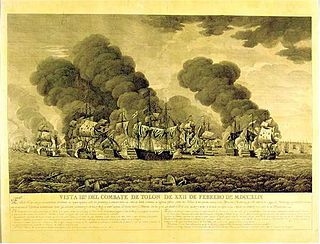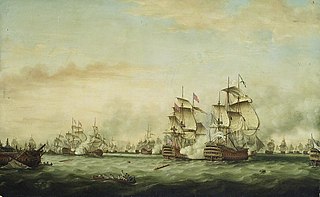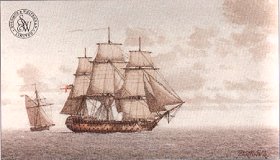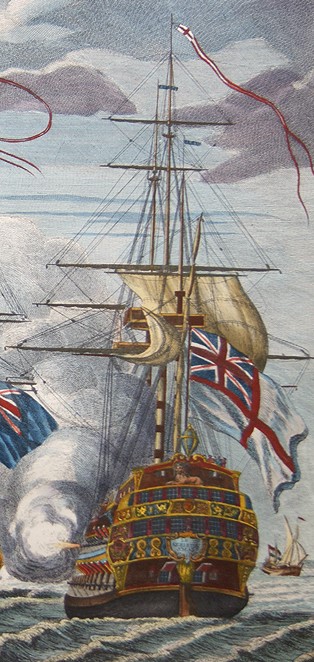
The Battle of Trafalgar was a naval engagement that took place on 21 October 1805 between the British Royal Navy and the combined fleets of the French and Spanish Navies during the War of the Third Coalition of the Napoleonic Wars (1803–1815).

Edward Hawke, 1st Baron Hawke,, of Scarthingwell Hall in the parish of Saxton with Scarthingwell, near Tadcaster, Yorkshire, was a Royal Navy officer. As captain of the third-rate HMS Berwick, he took part in the Battle of Toulon in February 1744 during the War of the Austrian Succession. He also captured six ships of a French squadron in the Bay of Biscay in the Second Battle of Cape Finisterre in October 1747.

The Battle of Toulon, also known as the Battle of Cape Sicié, took place between 21 and 22 February 1744 NS near the French Mediterranean port of Toulon. Although France was not yet at war with the United Kingdom of Great Britain, ships from their Levant Fleet sailed out to support a Spanish fleet, which was attempting to break through a two-year-old British naval blockade.

HMS Agamemnon was a 64-gun third-rate ship of the line of the British Royal Navy. She saw service in the American Revolutionary War, French Revolutionary, and Napoleonic Wars and fought in many major naval battles. She is remembered as Horatio Nelson's favourite ship, and she was named after the mythical ancient Greek king Agamemnon, the first ship of the Royal Navy to bear the name.

HMS Neptune was a 98-gun second-rate ship of the line of the Royal Navy. She served on a number of stations during the French Revolutionary and Napoleonic Wars and was present at the Battle of Trafalgar in 1805.

HMS Barfleur was a 90-gun second-rate ship of the line of the Royal Navy, designed by Sir Thomas Slade on the lines of the 100-gun ship Royal William, and launched at Chatham Dockyard on 30 July 1768, at a cost of £49,222. In about 1780, she had another eight guns added to her quarterdeck, making her a 98-gun ship; she possessed a crew of approximately 750. Her design class sisters were the Prince George, Princess Royal, and Formidable. She was a ship of long service and many battles.

Scipion was a 74-gun French ship of the line, built at Lorient to a design by Jacques Noel Sane. She was laid down as Orient in late 1798, and renamed Scipion in 1801. She was first commissioned in 1802 and joined the French Mediterranean fleet based at Toulon, in the squadron of Admiral Leissègues. Consequently, she was one of the ships afloat in that port when war with England reopened in May 1803. She participated in the Battle of Cape Finisterre and the Battle of Trafalgar. The British captured her in the subsequent Battle of Cape Ortegal. In 1810 she participated in the Java campaign, which in 1847 earned her surviving crew the Naval General Service Medal. She participated in the blockade of Toulon in 1813 and was paid off in 1814. She was broken up in 1819.

Neptune was a Bucentaure-class 80-gun ship of the line of the French Navy. Built during the last years of the French Revolutionary Wars she was launched at the beginning of the Napoleonic Wars. Her brief career with the French included several major battles, though she spent the last 12 years of her life under the Spanish flag.

Thomas Mathews was a British officer of the Royal Navy, who rose to the rank of admiral.
HMS Somerset was a three-decker 80-gun third rate ship of the line of the Royal Navy, launched at Chatham Dockyard on 31 May 1698. She was the first ship to bear the name.

HMS Edgar was a 74-gun third-rate ship of the line of the Royal Navy, that saw service in the American Revolutionary, French Revolutionary and Napoleonic Wars. Launched in 1779, she fought in the battles of Cape St Vincent and Copenhagen, two of the major naval engagements of the wars.

Vice-Admiral Sir Joshua Rowley, 1st Baronet was a Royal Navy officer who was the fourth son of Admiral Sir William Rowley. Sir Joshua was from an ancient English family, originating in Staffordshire (England) and was born on 1 May 1734. Rowley served with distinction in a number of battles throughout his career and was highly praised by his contemporaries. Unfortunately whilst his career was often active he did not have the opportunity to command any significant engagements and always followed rather than led. His achievements have therefore been eclipsed by his contemporaries such as Keppel, Hawke, Howe and Rodney. Rowley however remains one of the stalwart commanders of the wooden walls that kept Britain safe for so long.

HMS Modeste was a 64-gun third rate ship of the line of the Royal Navy. She was previously the 64-gun Modeste, of the French Navy, launched in 1759 and captured later that year.

HMS St Michael was a 90-gun second rate ship of the line of the Royal Navy, built by John Tippetts of Portsmouth Dockyard and launched in 1669.

Admiral Richard Lestock was an officer in the Royal Navy, eventually rising to the rank of Admiral. He fought in a number of battles, and was a controversial figure, most remembered for his part in the defeat at the Battle of Toulon, and the subsequent court-martial.

HMS Stirling Castle was a 70-gun third rate ship of the line of the Royal Navy, built at Chatham Dockyard to the 1733 proposals of the 1719 Establishment, and launched on 24 April 1742.

The Trafalgar campaign was a long and complicated series of fleet manoeuvres carried out by the combined French and Spanish fleets; and the opposing moves of the Royal Navy during much of 1805. These were the culmination of French plans to force a passage through the English Channel, and so achieve a successful invasion of the United Kingdom. The plans were extremely complicated and proved to be impractical. Much of the detail was due to the personal intervention of Napoleon, who as a soldier rather than a sailor failed to consider the effects of weather, difficulties in communication, and the Royal Navy. Despite limited successes in achieving some elements of the plan the French commanders were unable to follow the main objective through to execution. The campaign, which took place over thousands of miles of ocean, was marked by several naval engagements, most significantly at the Battle of Trafalgar on 21 October, where the combined fleet was decisively defeated, and from which the campaign takes its name. A final mopping up action at the Battle of Cape Ortegal on 4 November completed the destruction of the combined fleet, and secured the supremacy of the Royal Navy at sea.

The Algeciras campaign was an attempt by a French naval squadron from Toulon under Contre-Admiral Charles Linois to join a French and Spanish fleet at Cadiz during June and July 1801 during the French Revolutionary Wars prior to a planned operation against either Egypt or Portugal. To reach Cadiz, the French squadron had to pass the British naval base at Gibraltar, which housed the squadron tasked with blockading Cadiz. The British squadron was commanded by Rear-Admiral Sir James Saumarez. After a successful voyage between Toulon and Gibraltar, in which a number of British vessels were captured, the squadron anchored at Algeciras, a fortified port city within sight of Gibraltar across Gibraltar Bay. On 6 July 1801, Saumarez attacked the anchored squadron, in the First Battle of Algeciras. Although severe damage was inflicted on all three French ships of the line, none could be successfully captured and the British were forced to withdraw without HMS Hannibal, which had grounded and was subsequently seized by the French.
The Croisière de Bruix was the principal naval campaign of the year 1799 during the French Revolutionary Wars. The expedition began in April 1799 when the bulk of the French Atlantic Fleet under Vice-Admiral Étienne Eustache Bruix departed the base at Brest, evading the British Channel Fleet which was blockading the port and tricking the commander Admiral Lord Bridport into believing their true destination was Ireland. Passing southwards, the French fleet narrowly missed joining with an allied Spanish Navy squadron at Ferrol and was prevented by an easterly gale from uniting with the main Spanish fleet at Cádiz before entering the Mediterranean Sea. The Mediterranean was under British control following the destruction of the French Mediterranean Fleet at the Battle of the Nile in August 1798, and a British fleet nominally under Admiral Earl St Vincent was stationed there. Due however to St. Vincent's ill-health, operational control rested with Vice-Admiral Lord Keith. As Keith sought to chase down the French, the Spanish fleet followed Bruix into the Mediterranean before being badly damaged in a gale and sheltering in Cartagena.

HMS Intrepid was a 64-gun third rate ship of the line of the Royal Navy, originally built in Toulon for the French Navy. She was launched in 1740, as Sérieux and fought at the Battle of Toulon before her capture by the British at the First Battle of Cape Finisterre in 1747. After being renamed and refitted by the Royal Navy, she entered British service in late 1747. Between 1748 and 1752 she was assigned as a guard ship off the coast of Kent in south-east England.
















